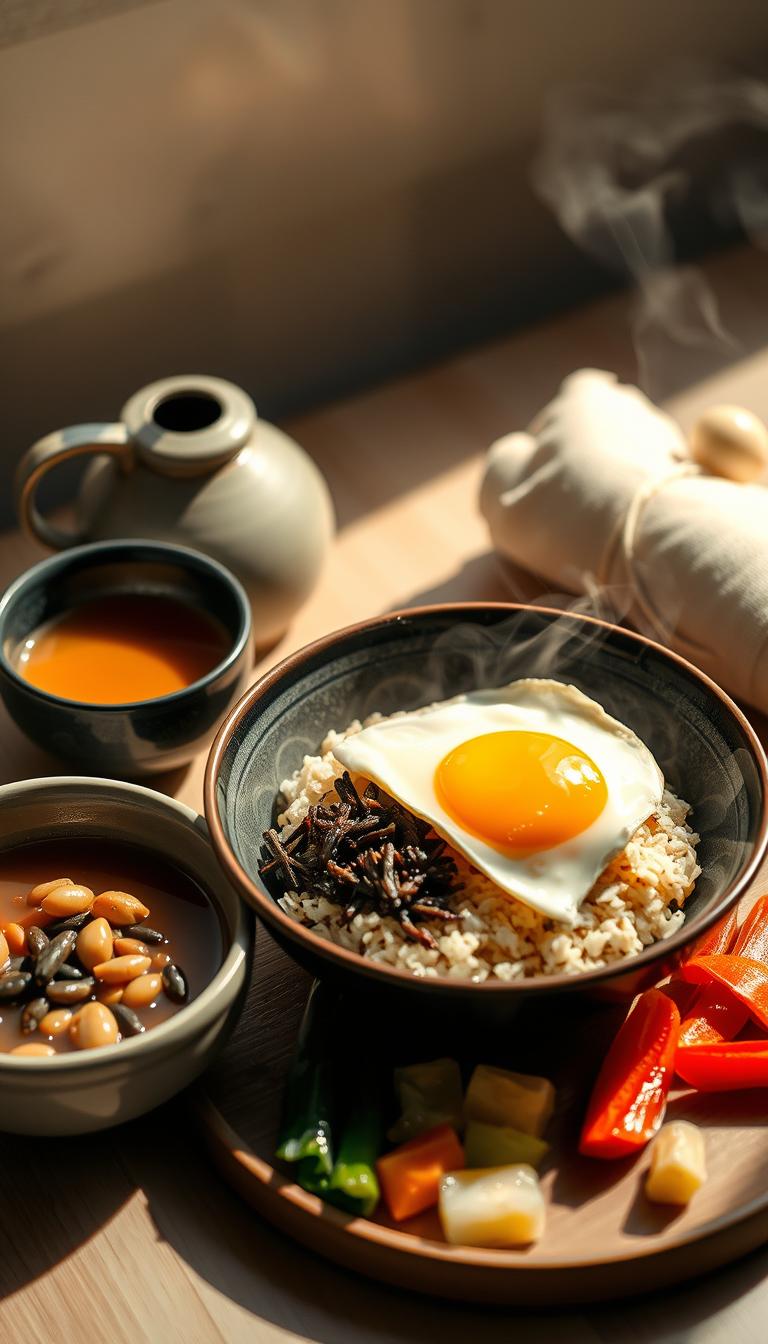Imagine a dish so simple yet so profound that it captures the essence of home and comfort in a single bowl. Tamago Kake Gohan, or TKG as it’s affectionately known in Japan, is a beloved breakfast staple that combines the humblest of ingredients into something extraordinary. At its core, it’s merely rice, egg, and soy sauce, but when these elements come together, they create a symphony of flavors and textures that is nothing short of magical.
Origin and Cultural Significance
Tamago Kake Gohan has roots deeply embedded in Japanese culinary tradition. This dish is a testament to the Japanese ethos of appreciating simplicity and purity in food. Historically, TKG became popular in the early 20th century as eggs became more readily available in Japan. It was a time when people sought nourishment in straightforward, accessible forms. The dish quickly grew in popularity, becoming a comforting breakfast for families across the country. It symbolizes the idea that even the simplest of foods can provide immense satisfaction and joy. In Japanese households, TKG is more than just a meal; it’s an experience that evokes nostalgia and warmth.
Unique Ingredients and Flavors
What sets Tamago Kake Gohan apart is its unique combination of flavors and textures. The key ingredients are freshly cooked rice, a raw egg, and a splash of soy sauce. The quality of these ingredients is paramount; each must be the best you can find. The rice should be perfectly steamed, fluffy, and hot, providing a warm bed for the raw egg. The egg, ideally organic and as fresh as possible, is cracked over the rice, allowing its richness to blend seamlessly with the grains. A drizzle of soy sauce ties everything together, adding umami depth that enhances every bite.
Techniques and Texture
The technique involved in making TKG is straightforward yet demands a certain finesse to achieve the perfect texture. The key is in the mixing—the egg must be thoroughly beaten with the hot rice until it forms a silky, creamy coating that envelops each grain. This gentle blending transforms the dish into a velvety delight that is both satisfying and comforting. Some variations include adding toppings such as chopped green onions, nori, or sesame seeds to introduce different flavors and textures, providing endless possibilities for customization.
In essence, Tamago Kake Gohan is a dish that exemplifies the beauty of simplicity, where each ingredient plays a crucial role in creating a harmonious balance. It invites you to slow down, savor each mouthful, and appreciate the profound comfort that can be found in the simplest of meals.

Tamago Kake Gohan
Description
Experience the simplicity and umami of a traditional Japanese breakfast with eggs, soy sauce, and rice in perfect harmony.
Ingredients
Basic Ingredients
Flavor Enhancements
Optional Garnishes
Instructions
Preparing the Ingredients
-
Gather Your Ingredients
Start by gathering a fresh egg, a bowl of steaming hot rice, soy sauce, and any optional toppings like chopped green onions or sesame seeds.Using the freshest egg possible is key to achieving the best flavor and texture.
Assembling the Dish
-
Crack the Egg
Carefully crack the egg into a small bowl, ensuring there are no shell fragments.If you're concerned about consuming raw eggs, use pasteurized eggs for peace of mind. -
Mix the Egg
Beat the egg gently with a fork or chopsticks until the yolk and white are well combined.This step ensures a uniform, smooth texture that will coat the rice evenly. -
Prepare the Rice
Place the hot rice in a separate bowl. The heat from the rice will slightly cook the egg, giving it a custard-like texture.Make sure the rice is steaming hot for the best results. -
Combine Egg and Rice
Pour the beaten egg over the hot rice, stirring quickly to coat every grain with the egg mixture.Don't hesitate to mix vigorously—this step is crucial for creating a creamy consistency. -
Season the Dish
Drizzle soy sauce over the egg-covered rice to taste. Start with a small amount and add more as needed.You can also add a dash of dashi or mirin for additional depth of flavor.
Final Touches
-
Add Toppings
Sprinkle your choice of toppings such as chopped green onions, sesame seeds, or a sprinkle of nori flakes.Feel free to get creative with your toppings; a touch of wasabi or pickled ginger can add a delightful zing.
Note
Use the freshest eggs possible for this dish, as the raw egg is the star ingredient. Look for local, organic eggs to ensure the best flavor and safety. When choosing rice, opt for a high-quality short-grain Japanese variety, such as Koshihikari, which offers a sticky texture perfect for absorbing the egg mixture. Be sure to rinse the rice thoroughly before cooking to remove excess starch, resulting in a fluffier outcome. Cook the rice with a tad less water than usual to achieve a slightly firmer texture, which pairs beautifully with the creamy egg. Once the rice is cooked, let it rest for about 10 minutes before fluffing with a fork to release steam and cool slightly. This helps the egg coat the rice evenly without scrambling. For an umami boost, add a few drops of soy sauce or tamari to the egg before mixing. A pinch of sea salt can enhance flavors, but season sparingly as you can always add more later. Experiment with toppings like chopped scallions, toasted sesame seeds, or a sprinkle of furikake for added texture and taste. If you're concerned about consuming raw eggs, you can lightly poach the egg in simmering water for a minute, though traditionalists may argue it slightly alters the dish's essence. Leftover tamago kake gohan can be stored in the refrigerator for a day, though it's best enjoyed fresh. However, if you do have leftovers, consider forming them into onigiri for a quick snack the next day. Pair this dish with a light miso soup or pickled vegetables to balance the rich, creamy flavors. If you're looking for a heartier meal, top with slices of avocado or a spoonful of natto for extra protein.

